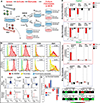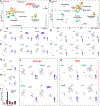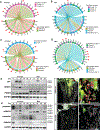Tissue-resident macrophages specifically express Lactotransferrin and Vegfc during ear pinna regeneration in spiny mice
- PMID: 38228141
- PMCID: PMC10922778
- DOI: 10.1016/j.devcel.2023.12.017
Tissue-resident macrophages specifically express Lactotransferrin and Vegfc during ear pinna regeneration in spiny mice
Abstract
The details of how macrophages control different healing trajectories (regeneration vs. scar formation) remain poorly defined. Spiny mice (Acomys spp.) can regenerate external ear pinnae tissue, whereas lab mice (Mus musculus) form scar tissue in response to an identical injury. Here, we used this dual species system to dissect macrophage phenotypes between healing modes. We identified secreted factors from activated Acomys macrophages that induce a pro-regenerative phenotype in fibroblasts from both species. Transcriptional profiling of Acomys macrophages and subsequent in vitro tests identified VEGFC, PDGFA, and Lactotransferrin (LTF) as potential pro-regenerative modulators. Examining macrophages in vivo, we found that Acomys-resident macrophages secreted VEGFC and LTF, whereas Mus macrophages do not. Lastly, we demonstrate the requirement for VEGFC during regeneration and find that interrupting lymphangiogenesis delays blastema and new tissue formation. Together, our results demonstrate that cell-autonomous mechanisms govern how macrophages react to the same stimuli to differentially produce factors that facilitate regeneration.
Keywords: Csf1r; Lactotransferrin; Vegfc; lymphangiogenesis; macrophage; regeneration; resident macrophage; spiny mouse; wound healing.
Copyright © 2024 Elsevier Inc. All rights reserved.
Conflict of interest statement
Declaration of interests At the time of publication, D.T. is employed by Glakosmithkline (GSK).
Figures







References
-
- Alexander KA, Chang MK, Maylin ER, Kohler T, Muller R, Wu AC, Van Rooijen N, Sweet MJ, Hume DA, Raggatt LJ, and Pettit AR (2011). Osteal macrophages promote in vivo intramembranous bone healing in a mouse tibial injury model. Journal of bone and mineral research : the official journal of the American Society for Bone and Mineral Research 26, 1517–1532. 10.1002/jbmr.354. - DOI - PubMed
Publication types
MeSH terms
Substances
Grants and funding
LinkOut - more resources
Full Text Sources
Medical
Molecular Biology Databases
Miscellaneous

